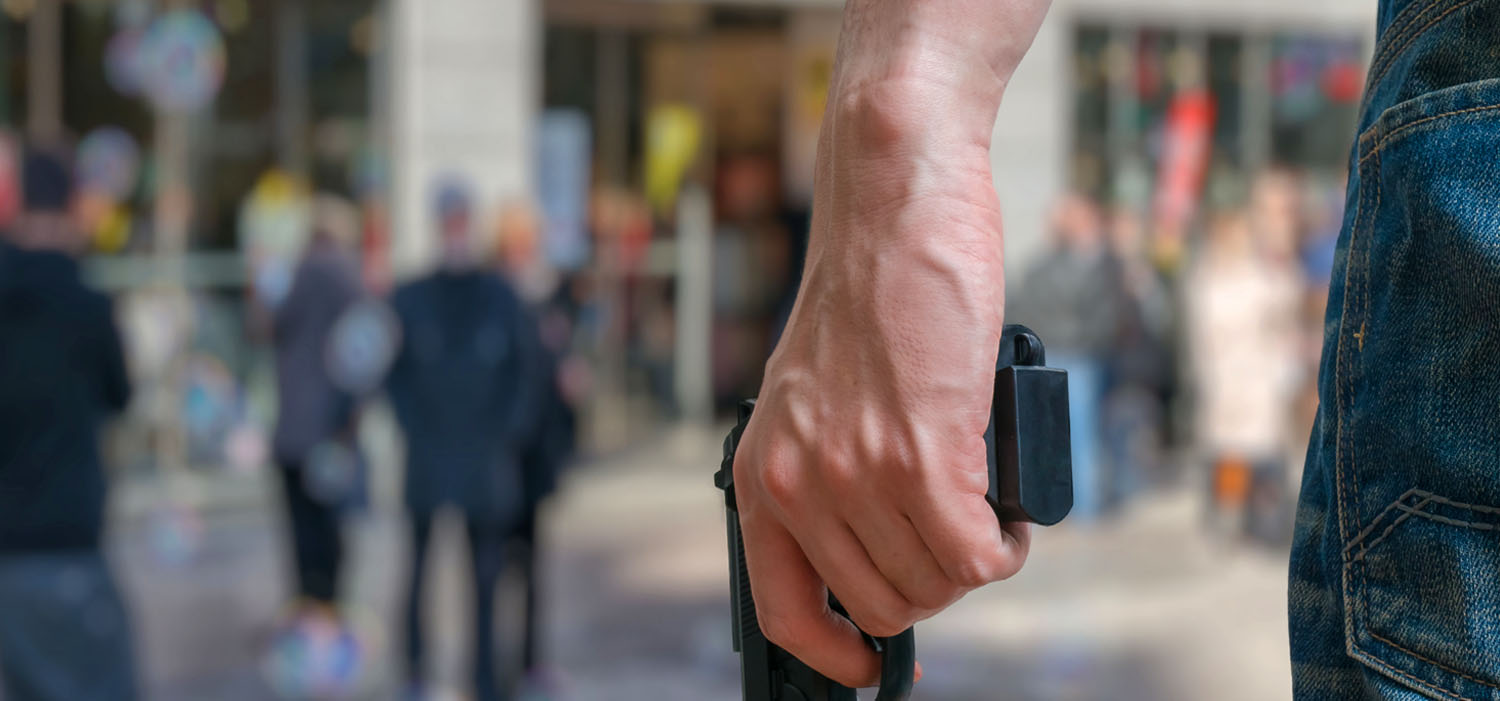
In an active shooter incident, understanding expectations, communication, and protocols can save lives. Formal training and open dialogue between sign language interpreters and the Deaf Community is vital.
Tara Adams attended a country music concert with her hearing husband and thirteen of their hearing friends. She was the only person who was Deaf in her group. She has cochlear implants. On the last night of the festival, during the final performance of the night, she heard what sounded like firecrackers going off. She didn’t really pay any attention to it, thinking it was part of the performance. A minute later, she heard them again, louder this time, and then her husband grabbed her hand and they both started running. People all around them were shouting “get down!” and laying down on the ground, thinking the shooter was at ground level and they were taking shelter by laying down and remaining still. Tara and her husband also thought the shooter was level with them, but they decided to keep running away from the sound of gunfire. They wouldn’t know until much later that people were getting shot from a room high up in the Mandalay Bay casino. She looked at her husband and was glad they both were safe. So far. By that time, the threat was long over. Fortunately, there were not any Deaf casualties in Las Vegas. Fortunately, there were not any Deaf casualties in the recent shootings at a church in Texas or at the elementary school in Northern California.
The following questions arise each time we experience an incident of this kind:
- How can Deaf people prepare for these kinds of incidents?
- What is the role of sign language interpreters and/or other professionals who work in the Deaf Community?
- Who provides training that would address all of these questions?
One thing is certain: Active Shooter Incidents are increasing in frequency and severity in the United States.
Only a Matter of Time
To date, there have not been any casualties from Active Shooter Incidents in the Deaf Community. Some Deaf relatives have had family members who were victims, but it is only a matter of time before an individual who is Deaf or hard of hearing becomes a victim. Knowing what to do and preparing in advance are the best indicators for surviving any emergency or disaster, and in that respect, Active Shooter Incidents are no different. Preparation matters. Training and practice save lives. As First Responders say: it’s not a matter of “if”, it’s a matter of “when.” Bad things are going to happen. The only questions are when they will happen and whether individuals and communities are prepared for them. To date, only a small number of trainings have been conducted specifically for the Deaf Community.
Police and Fire Departments Constantly Train
In order to satisfy licensure maintenance requirements, police and fire department personnel must re-qualify, renew certifications, and/or complete a certain number of continuing education or POST credits. Departments maintain accreditation and permit requirements by providing training opportunities for their personnel and receive state and federal funding by performing exercises on a regular basis. They train. Constantly.
Police Are Not There To Save You
When law enforcement officers engage in an Active Shooter Incident, they have one priority: eliminate the threat. The “threat” is the shooter. An Active Shooter Incident differs from a hostage situation in that the hostage taker’s priorities are a ransom or other goal and taking hostages is a means to that end. An Active Shooter Incident is unique in that the goal of the shooter is to kill, maim, or injure as many people as possible in the shortest amount of time. Law enforcement engages these threats differently. In a hostage situation, the goal is the safety and well-being of the hostages. In an Active Shooter Incident, the goal is to eliminate the threat, which means locating and stopping the shooter. Getting victims to safety is secondary to eliminating the threat.
Police will check each person they find for weapons, assuming the shooter is hiding among the victims. Police will not get victims to safety until after the threat has been located and/or eliminated. Police will give verbal commands. Non-compliance with verbal commands will be met with physically forced compliance. Police are in a hurry to eliminate the threat, they will not be focused on being soft or light or courteous. They will pat-down each person they come across and then verbally order them to stay down and stay put. This certainly has implications for Deaf and Hard of Hearing individuals who may not have access to verbal orders.
Firefighters and Emergency Medical Services Stage at a Safe Distance
Firefighters typically arrive at an Active Shooter Incident after law enforcement has already arrived. They have specific protocol and procedure for responding to incidents where there is a live and active threat: staging at a safe distance. Firefighters and emergency medical personnel will arrive and prepare to receive casualties. They are trained not to enter dangerous areas until those areas are deemed clear of threats by law enforcement personnel.
Run, Hide, Fight
Law enforcement personnel are not there to save you. EMS is not coming until the threat is eliminated. You are on your own. Every individual is responsible to prepare themselves. Some municipalities offer Active Shooter Awareness training free to the public. Some companies offer training for a fee. Methods and modalities differ greatly. The most widely used curriculum for Active Shooter Awareness training follows three basic courses of action depending upon an individual’s proximity to the threat: Run, Hide, Fight.
If you can safely avoid or escape the area where an active shooter is, do so. That’s what “Run” means. If you can’t safely flee, conceal yourself in a safe location, turn out the lights, and remain quiet in order to evade detection by the shooter. That’s what “Hide” means. And if you encounter the shooter, cannot flee and cannot conceal yourself, defend yourself to the best of your ability. That’s what “Fight” means.
Place, time of day, physical conditions of the individual, and weather can all factor into which response will be the best course of action for each person. Preparation is personal and person-specific.
Roles and Responsibility of the Sign Language Interpreter
Sign language interpreting contracts typically have a “force major” clause which renders the contract null and void should an interpreting assignment end or be canceled due to inclement weather, natural disaster, or emergency. Technically speaking, once the shooting starts, the sign language interpreter’s contractual obligations to provide communication and other access has ended. Since the interpreter is not contractually or legally obligated to interpret, the question then becomes what other obligations compel the Interpreter to continue providing access to individuals who are Deaf in an Active Shooter Incident? The sign language interpreter’s own sense of community might compel them to respond in a cooperative way, remain with the Deaf clients, and continue to provide access. But they are under no obligation to place themselves in danger in order to serve others. Sign language interpreters are not first responders, and there is no reasonable expectation for them to respond in any specific way. Nor would it be appropriate to judge them or hold them accountable for what they choose to do or choose not to do during an Active Shooter Incident.
One of the principal tenets of citizen response to emergencies and disasters is placing one’s own personal safety as the top priority. It is impossible to help others when you yourself are injured or incapacitated. For that reason, one’s own personal safety must be priority number one. After that comes concern for the safety of others. Of course, there will always be those among us who make the ultimate sacrifice for the benefit of others.
Victoria Leigh Soto was a teacher at Sandy Hook Elementary school. When a shooter entered the school and began going room by room shooting everyone in sight, she placed herself between the shooter and her students. The shooter shot her several times, and she chose to shield her students with her own body, perishing as a result. Nothing about her employment contract with the school system compelled her to do so. She elected of her own free will and choice to protect her students at the expense of her own life. This may be seen as the correct course of action from the outside perspective, but it must be remembered that no one has the right to demand another person place themselves in danger in order to protect others.
Preparation is the Key to Effective Response
Active Shooter Awareness training provides the preparedness essentials necessary for citizens to be ready to respond appropriately in an Active Shooter Incident. This training is ideally conducted in a safe and controlled environment and with the participation of local law enforcement personnel. Coordination with local law enforcement agencies is essential to effective preparation as part of a whole community response. Advanced Bleeding Control is an essential training for all citizens also. This teaches the participant how to perform life-saving emergency first-aid to help stabilize victims long enough to get to a hospital and receive the care they need to recover. Find out when the next training is near you. Plan to attend. Learn all you can. Ask questions. Get answers. Then ask how you can volunteer for your local agency’s next exercise. As First Responders say, “You respond the way you train.” And they train all the time. If you are serious about learning what to do in emergencies and disasters, start training with them.
Questions to Consider:
- What are the moral/ethical considerations for an American Sign Language Interpreter for the Deaf & Hard of Hearing in an emergency situation?
- What is the appropriate way to discuss plans in the event of an emergency between Sign Language interpreters and Deaf clients?
- Who is responsible for initiating the discussion?
References:
- The Daily Moth. (n.d.). Retrieved December 30, 2017, from https://www.facebook.com/TheDailyMoth/videos/754540961414473/





